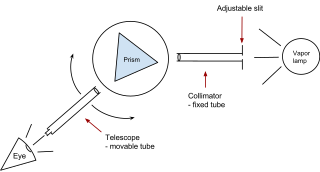Top Qs
Timeline
Chat
Perspective
Minimum deviation
Condition when the angle of deviation is minimal in a prism From Wikipedia, the free encyclopedia
Remove ads
In a prism, the angle of deviation (δ) decreases with increase in the angle of incidence (i) up to a particular angle. This angle of incidence where the angle of deviation in a prism is minimum is called the minimum deviation position of the prism and that very deviation angle is known as the minimum angle of deviation (denoted by δmin, Dλ, or Dm).



The angle of minimum deviation is related with the refractive index as:
This is useful to calculate the refractive index of a material. Rainbow and halo occur at minimum deviation. Also, a thin prism is always set at minimum deviation.
Remove ads
Formula
Summarize
Perspective
This section needs expansion with: the derivation of the expression for minimum deviation using Calculus. You can help by adding to it. (June 2020) |
In minimum deviation, the refracted ray in the prism is parallel to its base. In other words, the light ray is symmetrical about the axis of symmetry of the prism.[1][2][3] Also, the angles of refractions are equal i.e. r1 = r2. The angle of incidence and angle of emergence equal each other (i = e). This is clearly visible in the graph below.
The formula for minimum deviation can be derived by exploiting the geometry in the prism. The approach involves replacing the variables in the Snell's law in terms of the Deviation and Prism Angles by making the use of the above properties.
From the angle sum of ,
Using the exterior angle theorem in ,
This can also be derived by putting i = e in the prism formula: i + e = A + δ
From Snell's law,
[4][3][1][2][5][excessive citations]
(where n is the refractive index, A is the Angle of Prism and Dm is the Minimum Angle of Deviation.)
This is a convenient way used to measure the refractive index of a material(liquid or gas) by directing a light ray through a prism of negligible thickness at minimum deviation filled with the material or in a glass prism dipped in it.[5][3][1]
Worked out examples:
Also, the variation of the angle of deviation with an arbitrary angle of incidence can be encapsulated into a single equation by expressing δ in terms of i in the prism formula using Snell's law:
Finding the minima of this equation will also give the same relation for minimum deviation as above.
Putting , we get,
, and by solving this equation we can obtain the value of angle of incidence for a definite value of angle of prism and the value of relative refractive index of the prism for which the minimum angle of deviation will be obtained. The equation and description are given here

For thin prism
In a thin or small angle prism, as the angles become very small, the sine of the angle nearly equals the angle itself and this yields many useful results.
Because Dm and A are very small,
Using a similar approach with the Snell's law and the prism formula for an in general thin-prism ends up in the very same result for the deviation angle.
Because i, e and r are small,
From the prism formula,
Thus, it can be said that a thin prism is always in minimum deviation.
Remove ads
Experimental determination
This section needs expansion with: virtual simulation, video, detailed explanation, etc. You can help by adding to it. (May 2020) |
Minimum deviation can be found manually or with spectrometer. Either the prism is kept fixed and the incidence angle is adjusted or the prism is rotated keeping the light source fixed.[6][7][8]
Minimum angle of dispersion
Summarize
Perspective

This section needs expansion. You can help by adding to it. (May 2020) |
The minimum angle of dispersion for white light is the difference in minimum deviation angle between red and violet rays of a light ray through a prism.[2]
For a thin prism, the deviation of violet light, is and that of red light, is . The difference in the deviation between red and violet light, is called the Angular Dispersion produced by the prism.
Applications

One of the factors that causes a rainbow is the bunching of light rays at the minimum deviation angle that is close to the rainbow angle (42°).[3][9]

It is also responsible for phenomena like halos and sundogs, produced by the deviation of sunlight in mini prisms of hexagonal ice crystals in the air bending light with a minimum deviation of 22°.[3][10]
Remove ads
See also
References
External links
Wikiwand - on
Seamless Wikipedia browsing. On steroids.
Remove ads
















 ,
,  ...
...





 ...
...
















